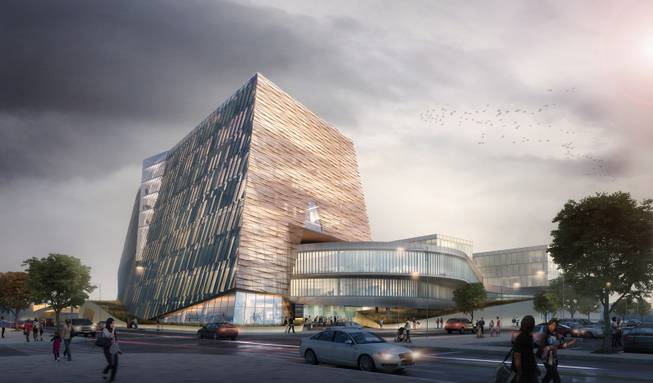
Image courtesy of TSK Architects / Co Architects
The future home of the UNLV School of Medicine.
Thursday, Sept. 6, 2018 | 2 a.m.
View more of the Sun's opinion section
Since 2005, more than 30 new medical schools have opened in the United States and many more are planned. My firm, Tripp Umbach, has been involved in more than 20 of these projects, including completing the economic impact study for the medical school at UNLV in Southern Nevada.
As UNLV and Las Vegas embark on a long overdue and expensive construction project to create a home for the UNLV medical school, its leaders should learn from other medical schools. While 21st-century medical school facilities share some of the characteristics of traditional medical schools developed at the turn of the 20th century, the absence or minimal nature of the medical library is the most striking difference, as information is no longer housed in a separate space but is available to all learners.
I cannot identify a single new medical school project in the United States that has focused on the medical library as a launch point, and with good reason.
Both new and traditional medical schools include familiar components such as classrooms, labs, lecture halls and food service. Although they continue to serve important functions, these spaces are being transformed to educate and train future physicians and other health professionals.
Cadaver labs where students perform surgery with preserved human bodies are replaced with high-tech simulation systems in which students can hit the “go back” button and start over on a procedure. Lecture halls are supplanted by high-tech classrooms with round tables to facilitate both large- and small-group learning and with many more “huddle spaces” for more intimate discussion and interaction among students and faculty.
Traditional private offices for faculty and large suites for the dean and other senior administrators are replaced with open office space models resembling those at Google and Facebook. The cafeteria has moved from the food line to open “grab-and-go” concepts present at modern airports, a wide variety of food available with swipe-card checkouts. Food remains the glue to stimulate interaction — provided that students and faculty unplug their earbuds, but that topic is for another day. I have noticed that food choices are becoming healthier as future health professionals are finally catching up with the impact of good nutrition.
The space most conspicuously absent is the library, a hub for research and study that historically has been located in a separate building on academic medical center campuses. Gone, too, are the private study cubicle and the computer lab. These spaces have disappeared as students and faculty have virtual access to information once housed in the library on their iPhones, tablets, watches and, soon, in body implants.
Last month I toured the new Stone Family Center for Health Sciences in Evansville, Ind. The first difference is the name, “Center for Health Sciences,” as the facility houses the Indiana University School of Medicine-Evansville as well as students from the University of Indiana School of Dentistry, the University of Southern Indiana and the University of Evansville and long-standing private institutions. While the tour guide did make a quick gesture to a small glass room, one the size of a New York studio apartment and identified as “Library” rather than resource center, we moved quickly to see the state-of-the-art virtual-reality suite. I asked the director of the center about the library’s puny stature, and he shared that all of the information in that glass room is available virtually throughout the facility and, for that matter, worldwide. The small library, like every other room in the building, carried a donor’s name but clearly was an afterthought in the design and not central to the education of medical and health science students.
In the 21st century, the wealth of information available to help prepare students for careers as physicians and health professionals is not limited within a dedicated space.
I urge Southern Nevada higher education leaders in partnership with private philanthropists to consider the lessons learned from contemporary medical schools as thy create a transformational facility not constrained by a traditional library.
Paul Umbach is the founder of Tripp Umbach, a consulting firm that provides community health needs assessments, economic impact studies, economic development and market research, and strategic plans for more than 1,000 clients throughout the U.S. and internationally. His work includes studies of the UNLV medical school for The Lincy Institute and the Nevada System of Higher Education.
